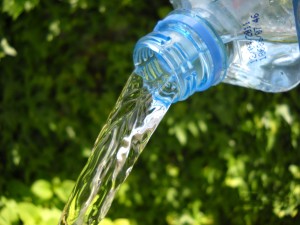Back Pain and Dehydration
Summer is here and in these warmer days dehydration can occur easily. Every day in the U.S., an estimated 75 percent of Americans are not drinking enough water.
Sixty percent of the human body is composed of water, but you’re constantly losing it. Every time you sweat, use the restroom or even breathe, water leaves your body. Replenishing this lost water is critically important for your health and day-to-day body functions. 
A few symptoms of dehydration are easily recognizable. These may include dry mouth, dry skin, dizziness and fatigue.
Below are some additional symptoms which may be hints about your body’s need for more water:
Back Pain: Without proper hydration, your body’s muscles stiffen and become sore. These stiff muscles can lead to painful spasms and slipped disks.
Headaches: The brain sits inside a fluid sack that keeps it from bumping against the skull, explains Higgins. If that fluid sack is depleted or running low because of dehydration, the brain can push up against parts of the skull, causing headaches. Headaches that begin in the neck, are caused by tightness of the neck muscles. Like back pain that is caused by dehydration, the neck muscles stiffen and become tight when deprived of water. Hydrating can help alleviate these symptoms, but spinal manipulation is normally required to resolve the issues in the neck that cause these headaches.
When it comes to hydration this summer, it is good to get in the routine of drinking 64 oz. of water each day. If you don’t love plain water, add some of fruit juice or fresh or frozen fruit to your water or, try naturally flavored, calorie-free seltzers. You can also swap carbohydrate snacks like chips and crackers, which have a very low water content, with fresh or frozen fruit, yogurt and vegetables, all which have a higher water content.
Heat vs. Ice
One of the more popular questions we get is whether ice or heat is best for pain and injuries. Both ice and heat are very beneficial at different times. The following are some guidelines on when to utilize each.
ICE
What does ICE do? Ice decreases pain by closing of small blood vessels. This helps limit the amount of swelling that occurs immediately after an injury. It also has a calming effect on nerves, which can decrease pain.
When to use ICE? The safest choice for treatment of injuries is ice. Ice is best for injuries less than 24 hours old or after activities that aggravate chronic conditions. Ice is good for migraine headaches, bumps, sprains and strains that occur with sports, slips, falls, and lifting.
Tips when using ICE – Ice an injury for no longer than 20 minutes at a time. Wait 1 hour before icing again. Ice or cold packs should never be put directly on the skin. Use a thin towel between your skin and the ice to help prevent a burn. To get added results for treatment of swelling, elevate the area being iced.
HEAT
What does HEAT do? Heat provides relief by opening of small blood vessels. Heat increases blood flow which promotes muscle relaxation and pain relief.
When to use HEAT? Heat is a great way to loosen up stiff joints and tight muscles. Heat is a good method of pain relief for postural muscle in your back and neck, tension headaches, muscle soreness, and spasms. Always wait 2-3 days after an injury before considering heat therapy.
Tips when using HEAT – Heat should also be applied in 20-minute intervals; waiting one hour between treatment. To avoid burning yourself, use several layers or towels between your skin and the heating pad. Also, avoid falling asleep while applying heat therapy by using a timer or automatic shut off. Never use heat if there is swelling or bruising.
When in doubt use ICE – Know that, when heat it is applied over an area of acute injury, active inflammation or swelling can get worse, as heat causes increased blood flow, the opposite of ice.
